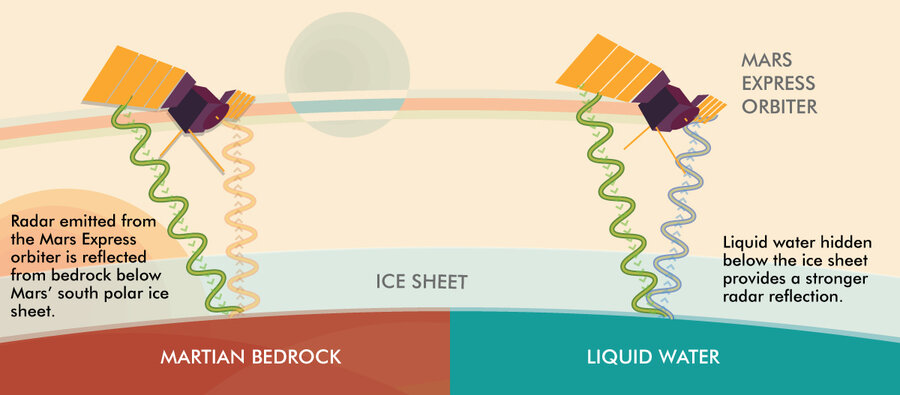Why a subglacial Martian lake raises hopes for alien life
Loading...
The Red Planet might not be as parched as scientists thought.
Liquid water, the key ingredient for all known life, has long proven elusive on Mars. In recent years, scientists have been teased by seasonal trickles thought to be evidence of water flowing just below the surface. But there’s been no evidence of large stores of the liquid stuff, until now.
Italian scientists announced Wednesday that they had discovered a surprising signature in radar data from the European Space Agency’s Mars Express orbiter. The only explanation that fit, they said, was that a 12-mile lake lurks beneath a mile of ice at the planet’s south pole.
Why We Wrote This
A huge reservoir of liquid water discovered beneath the southern Martian ice cap looks remarkably similar to subglacial lakes in Greenland and Antarctica, which are thought to host hordes of living organisms.
“This is incredibly exciting news,” says Kevin Hand, an astrobiologist and planetary scientist at NASA’s Jet Propulsion Laboratory. “If indeed Mars does harbor liquid water beneath the south polar deposits, then there’s the prospect of not just finding life within those regions, but finding extant life, life that’s alive today.”
Perhaps, scientists say, life was plentiful on a warmer and wetter Mars some 3.5 billion years ago, and it might have found refuge beneath the ice today.
Earth has its own mysterious subglacial lakes. And scientists have found a spectacular array of organisms can dwell in those frigid, dark, alien places – a discovery that has transformed how we view our own world. This discovery could do the same for Mars.
“When we look at a world, we’re looking at it through our perspective as surface-dwellers,” says Cynthia Phillips, a planetary geologist at NASA’s Jet Propulsion Laboratory. “The whole idea of there potentially being an active biosphere below the surface of Mars, that’s like science fiction. It really changes your perspective.”
Before subglacial lakes were discovered on Earth, Antarctica was seen as just a cold, dead block of ice sitting on rock. But that view has shifted in recent decades since the discovery of lakes hidden beneath that sheet of ice.
John Priscu was among the first to consider life in those forbidding waters in the 1990s, after the discovery of Antarctica’s Lake Vostok, the largest known subglacial lake. “When I started, nobody believed me,” says Dr. Priscu, a professor of ecology at Montana State University.
Over the years, the scientific community and funding agencies began taking Priscu and others more seriously. In January 2013, Priscu led a team to get the first direct look at a subglacial lake: Lake Whillans, a subglacial lake 2,600 feet below the ice sheet in western Antarctica. The team stuck a camera down the long bore hole, and pulled up a sample of the water and sediments in the lake.
They didn’t see any subglacial fish, but Lake Whillans was teeming with microbial life. “I think we transformed the way we see that continent – and our planet,” Priscu says.
The team had expected to find life, but its abundance and diversity came as a shock. Single-celled organisms were just as plentiful as in the open ocean.
“We just weren’t walking into this with the expectation that there was going to be a lot of food” for so many microbes to survive on, says Brent Christner, a microbiologist at the University of Florida, who was also on that science team.
The vast majority of organisms derive all their energy from the sun, either directly through photosynthesis or through the food chain. But scientists think the Lake Whillans microbes might be munching on minerals in the water and on the rock below.
Lake Whillans might not be representative of all subglacial lakes. For example, scientists think the more isolated Lake Vostok, which probably hasn’t seen sunlight in 15 million years, might host very unique life. Ice core samples from just above the lake hold tantalizing clues of life that might exist beneath, but they have yet to reach the liquid water itself.
Subglacial lakes on Earth are seen as good analogues for subglacial bodies of water on other worlds. “Studying those subglacial water systems on Earth can help us understand what are the possibilities and limitations of life in these extreme conditions and then apply that to other planetary bodies,” says Anja Rutishauser, a PhD student at the University of Alberta with expertise in remote sensing.
Ms. Rutishauser discovered the first subglacial lakes in the Canadian Arctic earlier this year by accident while surveying the region using the same technique used to make the latest discovery on Mars. And the lake system she spotted under the Devon Ice Cap could be an ideal analogue to a subglacial lake that might exist on Mars.
In both places, it should be way too cold for liquid water, but scientists suspect mineral salts from the rock below help keep it liquid by depressing the freezing point of water.
If there’s life in such a harsh system, says Rutishauser, “it could be a really unique ecosystem that we’ve never seen anywhere.”
Scientists think there are about 400 subglacial lakes worldwide, but they’ve only sampled one so far. Priscu is set to lead a team to Antarctica again this coming winter to sample a second subglacial lake, Lake Mercer.
Liquid water has been discovered hiding beneath thick ice sheets across the solar system in recent years, with this new evidence on Mars and detections of subsurface oceans on Saturn’s moon Enceladus and Jupiter’s moon Europa, making frigid subglacial lakes the hot new place in the search for extraterrestrials.
“It now appears that, whether it’s Mars or Europa or Enceladus,” says Hand, “deep liquid water environments out there in the solar system may provide some of the most habitable real estates to be found in our solar system.”






